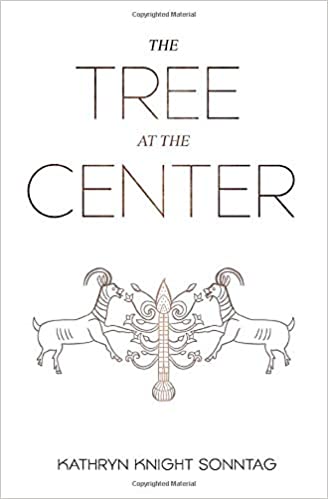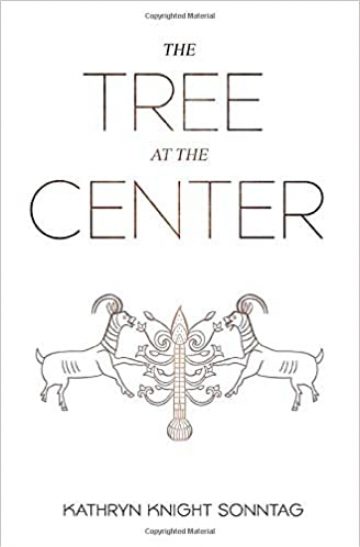
Kathryn Knight Sonntag’s collection of poems in The Tree at the Center explore the divine feminine through themes of nature, creation, joy, birth, and the center of things. Several of the poems are inspired by scriptures, the poetry breathing color into the verses, and references are notated in tiny font in the upper corner of the page. Other mythologies are interwoven with our scripture as Sonntag draws connections between Buddha’s bodhi tree, the seven-branched trunk of the menorah, the kadamba tree of Krishna, the myrrh tree that births Adonis, the Maypole, “The holy feet descending / the rungs of Jacob’s dreams.” (World Tree, p. 12)
“We plunge deep
from The Call, p. 14
into mythical time, to firmaments parting,
to the first dragonfly wing etched, then
humming. Let there be, I said,
and there was.”
As the author states in the introduction, “Where is a divine feminine figure located in LDS theology? Where does She lodge here on Earth? And because there isn’t a prescribed answer, every [person] must find Her for herself….The Tree at the Center is an eco-theological work that delves into the meaning of female exile….This is the story of women that has only been whispered peripherally in Mormonism.”
I do not often read books of poetry. I like poems, but I struggle with ciphers of symbolism. At the beginning of this book, even as some phrases and images shone off the page, I struggled a bit to glean meaning from the artfully wrought language. But toward the middle of the book (at the center, if you like), where the author focuses more on her own lived experience of giving birth, of postpartum depression, of new motherhood, a switch flipped for me and the layers of meaning in all of the poems came more easily.
I never asked to be the center,
(from As a Mother, p. 38)
the eternal tree,
a venus belly,
etched. But as your sweet body
latches to my breast, I
am Eve, the sun of my son–
who will carry the tree through himself
when he multiplies
and replenishes the earth.
Consider this book the flipside to Rachel Hunt Steenblik’s Mother’s Milk: where Steenblik’s poems are spare and simple and often rooted in the everyday, Sonntag’s poems are lyrical and complexly layered with themes from nature, mythology and scripture. Both styles are elegant; both volumes beautifully evoke the divine feminine.
Sonntag’s poetry requires you to sit with the words and images, to read slowly, to pause, to read it through again. I found this daunting at first, but effort notwithstanding, most of the poems are accessible even to poetry novices like me, and at 78 pages, The Tree at the Center is a slim volume, making it possible to both savor and digest.
The Tree at the Center
We talk often
of the Son’s surrender
His long suffering, His forever
atoning–the shards
of the universe, gathered
to reconcile all
the ways in which God
has been lost
to us.I want to know
about the surrender
of the Mother, if it felt at all
like a body
laid flat
as creation writhed
shaking the bed
of Earth while Her mind
broke
into shards, into the wilderness
into the wolf. No word, no language
separate from the surging
womb.I want to know
how death hit Her square
on the meatiest turn
of Her trunk, then dragged Her
from the forest–the embroidered branches
rent from Solomon’s temple–
to pierce Her stiff arms
with Her son’s.I want to know
p. 56
how a forest survives
without trees, how
we will welcome the Son
with the fires still burning.
Asherah, God the Mother, both gentle and devouring, is the thread that binds these poems together. She is depicted as a tree, as a wolf, as an eagle-winged seraph who “circles the edges / of the square, of the wilderness where / we have left Her, / watching.” The poems explore both Her presence and Her absence, and while I have always felt the feminine wound of worshiping a masculine God, these words describing “the temple we continue to build” captured the breadth of this loss, the depth of this cavity in my spirit and in my church: “the void at its center, the scar / of Her uprooting” (all from One Thousand Two Hundred Sixty Days, p. 55).
The Tree at the Center is a worthy addition to the growing collection of works exploring the search for the divine feminine. While Mother God is still largely absent from our theology, her loss like a treeless forest with “the fires still burning,” Sonntag leaves us with hope:
And maybe we have to consider
that if we find the fluttering heat
of maternal wings missing, […]that She, once in the midst of everything,
like the subtlest, sweetest fragrance of home,
must be restored. And whoare these temple priests
from Cube of Fire, p. 62
slated to return–the shadow of exile
dusting their trailing robes,
palm leaves in hand–if not you,
if not me?






One Response
The Tree at the Center book review is really interesting and the poems that are listed are excellent. So I was glad to see and read them and learn from the report. Thanks for it being here. Judith Curtis